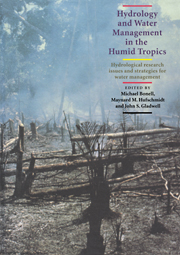 Hydrology and Water Management in the Humid Tropics
Hydrology and Water Management in the Humid Tropics Published online by Cambridge University Press: 23 December 2009
ABSTRACT
This chapter reviews briefly the hydrology and water resources of the humid tropic regions of Latin America and the Caribbean, following generally the definition of Chang and Lau (see the appendix to this book). For each subregion (Central America, Caribbean Islands and South America) descriptions of the climate, geomorphology and surface and groundwaters are described. It is concluded with a call for additional detailed assessments of the water resources of each country.
INTRODUCTION
The region under discussion in this section is that of the humid tropics as defined by Chang & Lau (1983). Figure 1 shows the areas of tropical Mexico, Central America, the Caribbean and tropical South America that are of concern.
The tropical regions of Latin America and the Caribbean are probably the most humid of the world. South America, for example, has some of the highest rainfall and runoff of any continent. Because most of the rivers of the region are rainfed, the seasonal distribution of the discharges is often directly related to the rainfall distribution. In the northern hemisphere, the incidence of tropical hurricanes can confuse the regionality of the rainfall amounts because of the non-uniformity with which the islands and mainland are impacted by these cyclonic events. Throughout the mainland of Latin America, the major physiographic factor affecting the water resources is the mountain chain that runs all the way from Mexico to Chile. This causes the rivers generally to be longer and larger on the Atlantic side (and contain some 84% of the land area), and shorter and with much higher gradients on the Pacific side.
To save this book to your Kindle, first ensure [email protected] is added to your Approved Personal Document E-mail List under your Personal Document Settings on the Manage Your Content and Devices page of your Amazon account. Then enter the ‘name’ part of your Kindle email address below. Find out more about saving to your Kindle.
Note you can select to save to either the @free.kindle.com or @kindle.com variations. ‘@free.kindle.com’ emails are free but can only be saved to your device when it is connected to wi-fi. ‘@kindle.com’ emails can be delivered even when you are not connected to wi-fi, but note that service fees apply.
Find out more about the Kindle Personal Document Service.
To save content items to your account, please confirm that you agree to abide by our usage policies. If this is the first time you use this feature, you will be asked to authorise Cambridge Core to connect with your account. Find out more about saving content to Dropbox.
To save content items to your account, please confirm that you agree to abide by our usage policies. If this is the first time you use this feature, you will be asked to authorise Cambridge Core to connect with your account. Find out more about saving content to Google Drive.